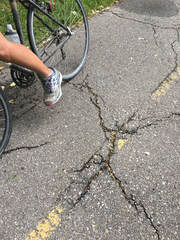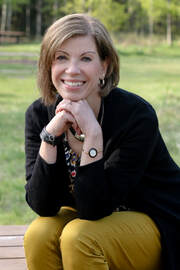
This bump is not big. It would not be hard to avoid. It sits right in the middle of the path. To give some perspective, the path is about eight feet wide, with a line down the middle, and the bump is right in the middle. The bump is only about eight inches in diameter. By rights, I should be biking on my own side of the path, not in the middle. I really should not ever hit this bump. In complete fairness, it is at the bottom of the little hill right where the path turns to the right, and there is an unobstructed view of any oncoming ‘traffic’ so it isn’t beyond the imagination that I would steer slightly left to make the turn at the bottom easy to do without too much braking. Still, you’d think by now I would have this figured out.
As I hit it for the umpteenth time early this week, I began to think about how I react to bumps in the road. As often happens when I start to ponder a thing, the universe cooperates nicely. This time she did not fail me; she provided plenty of real-life examples for me to do my study of bumps in the road.
Tuesday morning, I took the same route, hit the same bump and kept going. I decided to do a little out and back loop to add to my ride that day. This section of the path is slightly narrower, but is still plenty wide to accommodate bikes and pedestrians. It does have the feel of being narrow because the Bow River is on one side, with just a narrow bank separating it from the path, and a chain link fence on the other that spans about a kilometre. After I turned back at the end of the loop and came to the chain link section again, I came upon a couple of cyclists stopped in front of me. As I approached, I could see there had been some kind of accident and a female cyclist was laying across the path, trapped under her bike. I slowed and stopped at a bit of a distance back. Clearly, they were trying to sort things out and often too many helpers are not helpful after all.
As I waited and watched, I couldn’t help but think this was a real live bump in the road. I turned on my observation sensors. A lot of the bumps we encounter are going to be unexpected. From what I observed there were several distinct ways people had of dealing with this particular unexpected bump.
The first two cyclists to stop were the two young men who had been cycling toward the fallen woman when the incident happened. I later learned she had noticed them approaching, on their own side of the path. Wanting to be considerate, she moved slightly to the right of her side of the path, where there was the chain link fence. It seems she got just a bit too close to the fence for a second, just long enough for her right handlebar to catch in one of the links, and send her flying, ultimately trapping her in the frame of her bike. The two men felt absolutely awful. They were repeatedly apologizing in a very Canadian way, although it turns out they did absolutely nothing wrong. They stayed with the woman and tried to help.
They kept trying to help her up, which was impossible because of the way the bike was laying. She eventually, although she was in shock, told them how to help her up, bike and all, after which she was able to untangle from the bike. These guys dealt with the bump in the road by being reactive. This was not bad; they did their best to make a bad situation as good as they could figure out how to. This was a kind of ‘patch it up as best we can’ approach. They left the situation having done their best, but feeling very badly nonetheless.
The second kind of reaction I observed came from one member of a group of six cyclists who cycled up behind me, and behind two other cyclists who were also behind me, after I had been stopped for a couple of minutes. I’m sure the poor lady on the ground wondered how in the world this little section of the path had suddenly become so popular. After these six took in the situation, (I can only assume they thought that since an ambulance didn’t need to be called, there was no need to stick around) one of the men, a man in his late 60’s or early 70’s, asked loudly, ‘Can we at least get past?’
Being a former teacher comes in handy in this sort of situation. I was already close to this man, since he clearly had not remembered to observe social distance when he muscled his way up beside me, so I had the teacher trick of ‘get in close proximity’ in my pocket. I also employed my very effective teacher ‘look’, and quiet, no-nonsense voice that told him that unless he wanted to cycle over top of the woman, he’d have to wait a minute like everyone else. This kind of person seemed to see the bump in the road as nothing but a nuisance. Since it did not apply to him directly, he wanted to get on with far more important things. I’m guessing he left the situation only thinking about how it had been an inconvenience for him.
The two cyclists who came up right after me took a different, also not bad, approach. They waited quietly, noticed that enough others seemed to be involved and then passed on through once the path was clear.
My reaction was different than all of the others too. I was lucky in that I had time to think about my reaction as I stood watching. As I heard the others offering to call someone for her to come to get her, and her replying in her ‘shocky’ voice that she would just stand beside the fence for a while until she felt better, I thought I would hang around for a minute. I’ve experienced laying splayed on the road, once with a broken collarbone and four broken ribs, once with a broken foot. It’s embarrassing, it really hurts, it’s surreal, it's scary, and it’s impossible to think clearly. So, once the others slowly pedalled off, I pulled my bike up beside her and said that I was just going to wait with her for a bit until she felt better. I know that when people are in crisis, they often don’t know what they need, so asking what I could do to help would not have been helpful. As we stood together, she began to tell me what had happened. She was in tears and badly shaken up. Eventually we checked her bike to determine if it was rideable, since she really wanted to get home under her own steam. I understood this too – the old get back up on the horse theory.
Once we saw the bike would be ok for her ride home, I told her I was going to slowly ride with her. I said I would ride in front of her, not behind, because she did not need me watching her as she tested her confidence. We rode along very slowly for about a kilometre. She called out that she thought she was doing ok. I called back some encouragement and suggested we see how her gears shifted as we went up and over a pedestrian bridge. That worked too. Eventually, when I felt she was doing pretty well, I pulled over. We chatted a bit and once I thought she was ok to be on her own, we parted ways. My reaction wasn’t perfect, but I did feel good about it as I went on my way.
Later this week I had another place to practice dealing with bumps. I was out pedalling and had a flat tire. Once I stopped and saw the problem, because I had been thinking about bumps, I said to myself not, ‘Oh rats, I have a flat tire!’ but rather, ‘Oh, this is a bump’. This simple act of identifying the situation as a bump allowed me to understand very quickly that I had complete control over, not the tire, but my way of dealing with it. I wanted to leave this situation feeling as good about my response as I had earlier in the week. I pulled over to the side, called Jim so he could provide back up if I needed it, got out my trusty tools, and sat down to get to work. I have now changed my very first tire all by myself!
We all experience bumps. This year, the road has been filled with them. We can practice noticing them, naming them ‘bumps’, and choosing how we’ll respond. It gives us a sense of control, and like many things, the more we practice, the better we get at taking the reactiveness out of our response.
May you watch for bumps in your road this week and be delighted with your ability to navigate them.
My inquiry for you this week is, ‘What opportunity does this bump provide?’
Elizabeth is a certified professional Leadership Coach, and the owner of Critchley Coaching. She is the founder and president of the Canadian charity, RDL Building Hope Society. She works with corporations, non-profits and the public sector, providing leadership coaching. She creates and facilitates custom workshops for all sizes of groups. She has particular expertise in facilitating Strategic Plans for organizations. Contact Elizabeth to learn how to navigate bumps in your road.


 RSS Feed
RSS Feed